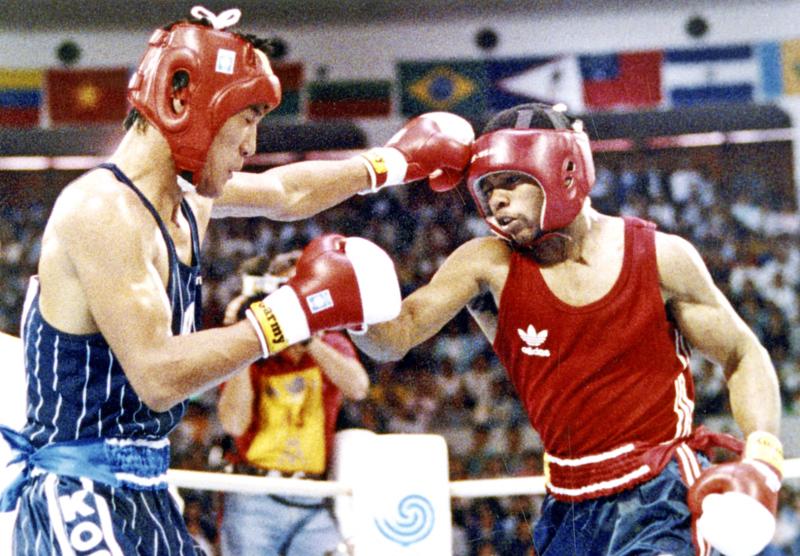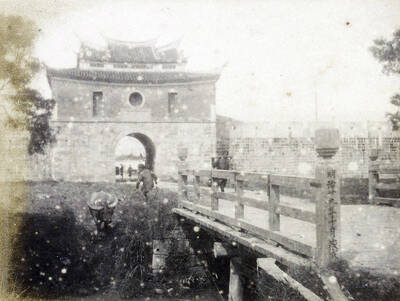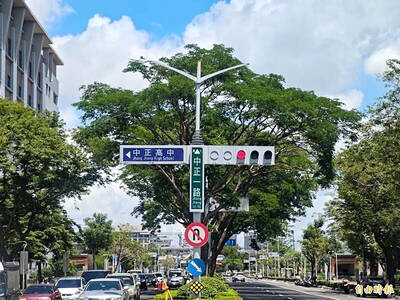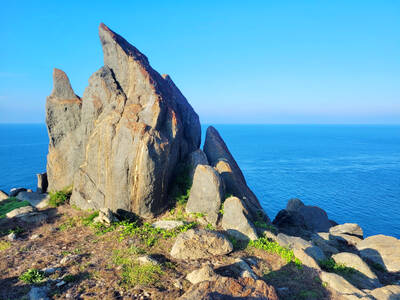The final Olympics of the Cold War era took place in what remains as the standoff’s last frontier 32 years later. The two weeks of events during the sweaty summer of 1988 had an impact that reached far beyond sports and influenced the shaping of South Korea as the nation it is today.
Following decades of post-war rebuilding and struggles against military dictatorships, South Korea saw the games as an international coming-out party.
Only the second ever Summer Olympics to be held in Asia after the 1964 Games in Tokyo, more than 8,000 athletes from a then-record 159 countries competed.

Photo: AP
It became the last Olympics for Communist powerhouses Soviet Union and East Germany, which the South Korean hosts were elated to bring on board after they had boycotted the 1984 Games in Los Angeles.
There was an abundance of star power that generated huge buzz, highlighted by a showdown between Carl Lewis of the US and Ben Johnson of Canada in the men’s 100-meter sprint.
The massive preparations for the Games gave Seoul a dramatic face-lift, with the construction of new roads, bridges and subway lines, the emergence of massive sports complex and huge public parks alongside the Han River, and the remaking of old commercial districts where towering concrete buildings rose above the rubble of old shops and offices.
But the Olympics also had a dark side. The preparations also included ruthless house clearings that removed hundreds of thousands of residents from their homes in slums and low-income settlements, which the country’s military leaders saw as crucial in beautifying the city for foreign visitors.
In a separate attempt to “purify” urban environments of vagrants, the government ordered nationwide police roundups that resulted in thousands — including homeless and disabled people, as well as children — being snatched off the streets and detained at facilities where many were abused.
Army general Chun Doo-hwan’s regime had apparently hoped that staging the Olympics would help legitimize his rule and divert public attention away from his bloody suppression of pro-democracy protests that left hundreds of people dead in the southern city of Gwangju in May 1980. But his government eventually bowed to popular pressure and accepted free presidential elections in the summer of 1987.
The buildup to the Games was also clouded by a belligerent North Korea, which the South blamed for the bombing of a South Korean passenger jet that killed all 115 aboard in December 1987. Seoul saw the attack as an attempt to scare away Olympic athletes and visitors. The North, which at one point demanded to co-host the Olympics, boycotted the Seoul Games.
At the tracks, stadiums and pools, the accomplishments of athletes were often overshadowed by major scandals and controversies.
In the 100-meter final, Johnson beat Lewis comfortably with a world record time of 9.79 seconds, only to have his gold taken away two days later after lab officials revealed he had tested positive for an anabolic steroid. The first Olympic megastar to be disqualified for performance enhancing drugs, Johnson’s case shocked the world and raised public awareness about a growing doping problem in sports.
In boxing, the sport’s future all-time great Roy Jones Jr of the US lost a 3-2 decision to South Korea’s Park Si-hun in the men’s light middleweight final despite clearly out-punching him for three rounds, an outcome that drew jeers even from the South Korean-heavy crowd.
Another boxing controversy involved a bantamweight fight between South Korea’s Byun Jong-il and Bulgaria’s Alexander Hristov. After Hristov was announced the winner, South Korean boxing officials and coaches stormed to the ring and threw punches, kicks and a chair toward referee Kevin Walker of New Zealand, who avoided serious injury but fled the country hours later.
The Soviet Union dominated the medal table with 55 golds, followed by East Germany and the US, which won 37 and 36 golds respectively. The South Koreans came in at a surprising fourth after winning 12 golds.
East German swimmer Kristin Otto led all athletes with six gold medals. American swimmer Matt Biondi won seven medals, including five golds.
South Korea touted the Seoul Olympics as an overall success and continued a shopping spree of mega-sporting events. The country shared the 2002 soccer World Cup with Japan before holding the 2018 Winter Olympics in the sleepy ski resort town of Pyeongchang.
After sitting out the Seoul Games, North Korea sent hundreds of athletes, officials and artists to Pyeongchang, including the powerful sister of leader Kim Jong-un, who conveyed his desires for a summit with South Korean President Moon Jae-in.
The Korean leaders ended up meeting and agreed to send combined teams to the now-delayed Tokyo Summer Games and pursue a joint bid for the 2032 Olympics.
Such commitment now looks all but dead after a quick deterioration in inter-Korean relations amid a stalemate in larger nuclear negotiations between Washington and Pyongyang.
North Korea has severed virtually all cooperation with the South and blew up an inter-Korean liaison office in its territory in June, following months of frustration over Seoul’s unwillingness to defy US-led sanctions over its nuclear weapons program and restart joint economic projects that would help the North’s broken economy.

June 9 to June 15 A photo of two men riding trendy high-wheel Penny-Farthing bicycles past a Qing Dynasty gate aptly captures the essence of Taipei in 1897 — a newly colonized city on the cusp of great change. The Japanese began making significant modifications to the cityscape in 1899, tearing down Qing-era structures, widening boulevards and installing Western-style infrastructure and buildings. The photographer, Minosuke Imamura, only spent a year in Taiwan as a cartographer for the governor-general’s office, but he left behind a treasure trove of 130 images showing life at the onset of Japanese rule, spanning July 1897 to

One of the most important gripes that Taiwanese have about the Democratic Progressive Party (DPP) is that it has failed to deliver concretely on higher wages, housing prices and other bread-and-butter issues. The parallel complaint is that the DPP cares only about glamor issues, such as removing markers of Chinese Nationalist Party (KMT) colonialism by renaming them, or what the KMT codes as “de-Sinification.” Once again, as a critical election looms, the DPP is presenting evidence for that charge. The KMT was quick to jump on the recent proposal of the Ministry of the Interior (MOI) to rename roads that symbolize

On the evening of June 1, Control Yuan Secretary-General Lee Chun-yi (李俊俋) apologized and resigned in disgrace. His crime was instructing his driver to use a Control Yuan vehicle to transport his dog to a pet grooming salon. The Control Yuan is the government branch that investigates, audits and impeaches government officials for, among other things, misuse of government funds, so his misuse of a government vehicle was highly inappropriate. If this story were told to anyone living in the golden era of swaggering gangsters, flashy nouveau riche businessmen, and corrupt “black gold” politics of the 1980s and 1990s, they would have laughed.

It was just before 6am on a sunny November morning and I could hardly contain my excitement as I arrived at the wharf where I would catch the boat to one of Penghu’s most difficult-to-access islands, a trip that had been on my list for nearly a decade. Little did I know, my dream would soon be crushed. Unsure about which boat was heading to Huayu (花嶼), I found someone who appeared to be a local and asked if this was the right place to wait. “Oh, the boat to Huayu’s been canceled today,” she told me. I couldn’t believe my ears. Surely,